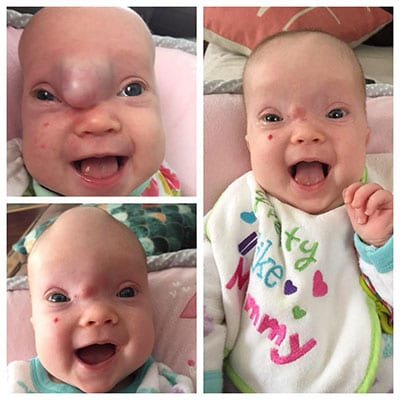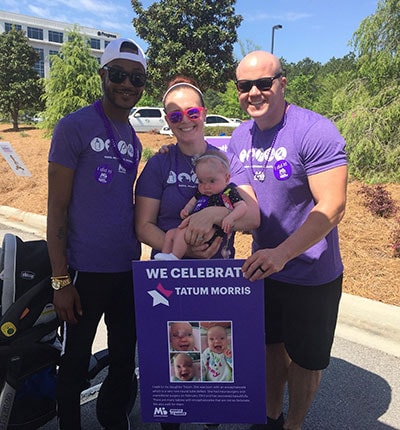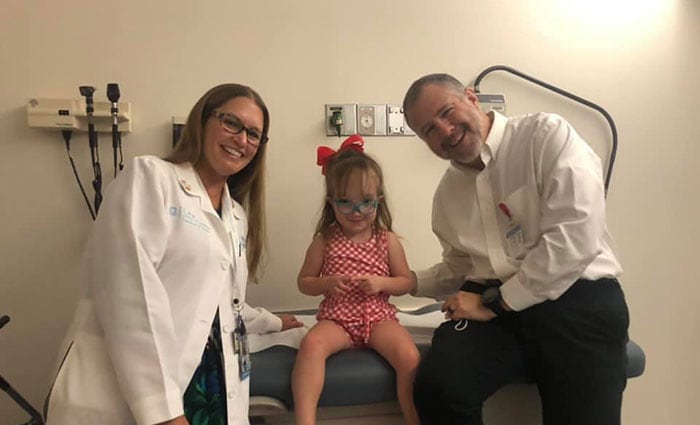Real Stories: Living with Encephalocele
Encephalocele is a rare type of birth defect of the neural tube that affects the brain. Encephalocele is a sac-like protrusion or projection of the brain and the membranes that cover it through an opening in the skull. To learn what it’s like to live with this condition or how families are affected, read this real story from people living with encephalocele.
Tatum’s Story – Written by her mom, Brandi

In October 2017, my husband and I went for an elective 4D ultrasound hoping for one last round of cute pictures of our girl. She had previously had normal scans, so our doctor advised that we did not need any further imaging before she was born. With the 4D ultrasound, we had hoped to see who she looked like and if she had any hair. Instead, the technician was very serious and pointed out what appeared to be a small growth above her nose. The technician told us that she did not want to alarm us but recommended that we follow up with our doctor to have it looked at. Of course, this sent me into “panic mode,” and we were able to get an appointment the next day with our doctor. Our doctor and the technician reviewed the photos taken at the 4D ultrasound studio and immediately sent us over to a specialty center for another ultrasound. A second ultrasound confirmed what we saw on the previous ultrasound, and we were referred for a fetal MRI.
My husband and I were both incredibly nervous on the morning of the MRI, but hopeful that the small growth was just a mole, birthmark, or soft tissue. A phone call later that afternoon confirmed our worst fears: our sweet baby girl had a frontal encephalocele. Encephalocele happens when the neural tube does not close completely during pregnancy. The result is an opening anywhere along the center of the skull from the nose to the back of the neck, often at the back of the head, at the top of the head, or between the forehead and the nose.

Shortly after diagnosis, we met with a pediatric neurosurgeon to discuss what all of this meant for our little one. After an incredibly emotional long weekend, we were given hope for an otherwise healthy, normal baby. We found out that encephalocele is an extremely rare neural tube defect (about 1 in 10,500 babies are affected) and typically occurs in the back of the skull in females. We are extremely lucky that hers is in the front of her skull impacting the right frontal lobe of her brain rather than the occipital area. Babies born with an occipital encephalocele only typically have about a 55% survival rate and can suffer lifelong complications. The neurosurgeon told us that the front of the brain is much more “forgiving” than the back and typically regulates personality (which you wouldn’t expect to change when operating on a newborn baby as they are developing personality as they grow). Fortunately, it was a relatively small encephalocele, measuring about 2.66 cm at its largest point. We were also told that the rest of her brain and all of her other organs appeared to be healthy, and her growth was right on target.
Tatum was scheduled to arrive via C-section a few days early to make sure she wouldn’t have any type of damage to the protruding tissue while coming though the birth canal. When she was born, we were overjoyed to see that the encephalocele was covered by skin. She was thoroughly examined by the hospital staff before they determined that she was healthy enough to go home with us for recovery until her first surgery. Tatum’s first surgery lasted approximately 5-6 hours and consisted of the removal of the protruding portion of her right frontal lobe and reconstruction of the bones that make up her face. She proved to us how tough she is by only taking Tylenol after having a major surgery. She was even able to go home after just three nights in the hospital.

Fast forward to Tatum’s second major surgery – which took more than 9 hours! The second surgery involved her neurosurgeon and a pediatric plastic surgeon. During her second surgery, the doctors removed the small, remaining portion of her non-functional right frontal lobe and completed a bone reconstruction of her eye sockets, forehead, and nasal bridge. The post-op appointments have all gone great and she healed very quickly. Tatum may need an additional repair around 8 years old with the plastic surgeon, but that determination will be made as she grows and matures. We have learned so much on this journey and are so thankful for our strong, tough, amazing little girl!
